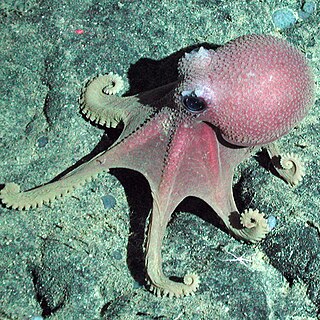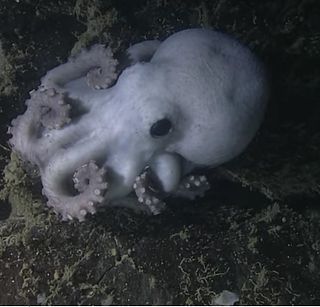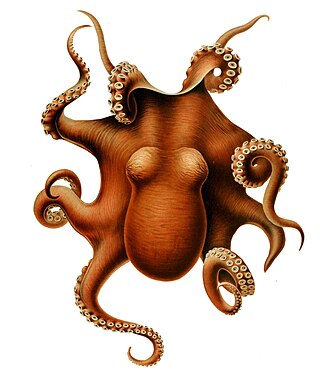
Blue-ringed octopuses, comprising the genus Hapalochlaena, are four extremely venomous species of octopus that are found in tide pools and coral reefs in the Pacific and Indian oceans, from Japan to Australia. They can be identified by their yellowish skin and characteristic blue and black rings that can change color dramatically when the animal is threatened. They eat small crustaceans, including crabs, hermit crabs, shrimp, and other small sea animals.

The Octopodidae comprise the family containing the majority of known octopus species.

Enteroctopus is an octopus genus whose members are sometimes known as giant octopuses.

Bathypolypus is a genus of octopuses in the monotypic family Bathypolypodidae.
Teretoctopus is a genus of octopuses in the family Octopodidae.

Pareledone is a genus of octopuses in the family Megaleledonidae.

Graneledone is a genus of octopuses in the family Octopodidae. The type species is Eledone verrucosaVerrill, 1881.
Thaumeledone is a genus of octopuses in the family Octopodidae found in deep waters in the Southern Hemisphere.

Scaeurgus is a genus of octopuses in the family Octopodidae. The species of this genus are characterized by inhabiting the upper bathyal benthic zone from temperate and tropical latitudes in all major oceans.

Amphioctopus is a genus of octopuses comprising around 16 species.

Callistoctopus is a genus of nocturnal, orange octopuses in the family Octopodidae. They are readily identifiable by their reddish coloring, the white papillae that line their bodies, and their long arms. Though sympatric with diurnal Octopus species, they avoid competition by hunting at night. In acknowledgement of this preference, many species of Callistoctopus are referred to as night octopuses. Well-known species include C. macropus and the type species C. ornatus, both of which are harvested for human consumption as seafood.

Megaleledonidae is a family of octopuses in the superfamily Octopodoidea. It was formerly placed in the family Octopodidae sensu lato as the subfamily Megaleledoninae but more recent studies have raised this taxon as a valid family. Megaleledonidae contains about 43 species in 12 genera.
Microeledone mangoldi, the sickle-tooth pygmy octopus, is a species of octopus from the family Megaleledonidae. This species was described in 2004, the type specimen being a male which was collected from a depth of approximately 1,000 m (3,300 ft) near the Norfolk Ridge, in the southwest Pacific Ocean near New Caledonia. It is a very small octopus which has a single row of suckers, lacks an ink sac and has a radula with seven rows of teeth with the unique central tooth, called the rechidian tooth, being curved with a grooved tip. The remaining teeth are flat and plate like and so are also distinctive. The smooth creamy-pink body lacks any chromatophores. The specific name honours the Swiss malacologist and marine biologist Katharina Mangold-Wirz (1922-2003).

Muusoctopus is a cosmopolitan genus of deep-sea octopus from the family Enteroctopodidae. These are small to medium-sized octopuses which lack an ink sac. Recent work has suggested that these octopuses originated in the North Atlantic and subsequently moved into the North Pacific while the species in the Southern Hemisphere are descended from multiple invasions from northern oceans.
Sasakiopus is a genus of octopus containing only one species, Sasakiopus salebrosus, the rough octopus. It is part of the family Enteroctopodidae. Genetic analysis appeared to show that S. salebrosus is the sister taxon of the genera Benthoctopus and Vulcanoctopus, although the former is now considered a synonym of Bathypolypus, the only genus in the family Bathypolypodidae, and the latter as a synonym of Muusoctopus.
Cistopus is a genus of octopuses in the family Octopodidae from the Indo-Pacific region, colloquially known as old-lady octopuses. For a long time it was thought that Cistopus was monotypic with the type species, C. indicus, being the only known species. This species was characterised by the possession of eight small mucus filled pouches around the animal's mouth in the web between the bases of each arm, these have an opening which releases the mucus. The function of these pouches is unknown. A new species, C. taiwanicus was described in 2009 from Taiwan. Octopuses in the genus Cistopus are harvested and utilised for food on a commercial basis in southern and eastern Asia. Further new species have been described since then.
Galeoctopus lateralis, the sharkclub octopus, is a species of octopus, from the family Octopodidae. This species was described in 2004 from specimens collected at depths of 200–400 m in the southern and western Pacific Ocean. It is a small octopus in which the mature males have a distinctive ligula which superficially resembles a shark's jaw and head including teeth‐like lugs. Other distinguishing characteristics include a lateral mantle ridge, a skin sculpture which includes star-shaped papillae, and the females have oviducts with hare distally swollen.
Macrochlaena winckworthi, Winckworth's octopus, is a little known species of octopus, it is the only species in the monotypic genus Macrochlaena, in the family Octopodidae. It was described by the British malacologist Guy Coburn Robson in 1926, the type specimens having been collected in the Gulf of Mannar, off Thoothukudi in Tamil Nadu, southeastern India.

Macrotritopus is a poorly known genus of octopuses in the family Octopodidae. As it stands, Macrotritopus contains one valid described species, Macrotritopus defilippi. Two poorly described, unresolved taxa which are known only from planktonic hatchlings have been tentively assigned Macrotritopus equivocus and M. scorpio, as well as a further three undescribed Indo-Pacific species. Macrotritopus was originally described from a single juvenile specimen which was named Macrotritopus equivocus notable for having an elongated third arm. This specimen gave the name Macrotritopus larva to this form of paralarva which was misidentified as the newly hatched juveniles of Scaeurgus unicirrhus. When the eggs of M. defilippi, which were kept in captivity, hatched and the resultant larvae were observed to be of the Macrotritopus larval type then the juveniles were connected with the adults. This means that the type species of Macrotritopus is a juvenile and that M. defillipi is the only species where the adult form is known. The presence of Macrotritopus larvae” off South Africa and the Indo‑West Pacific from Australia to Hawaii indicates that there may be a number of yet to be described species within this genus.
Teretoctopus indicus is a species of octopus within the family Octopodidae. Its believed to live in the Western Indian Ocean, although the species is only known from its type locality from the Arabian Sea at a depth of 1000 meters. It has been classified as 'Data deficient' by the IUCN Red List, as there is little to no knowledge of this species.










